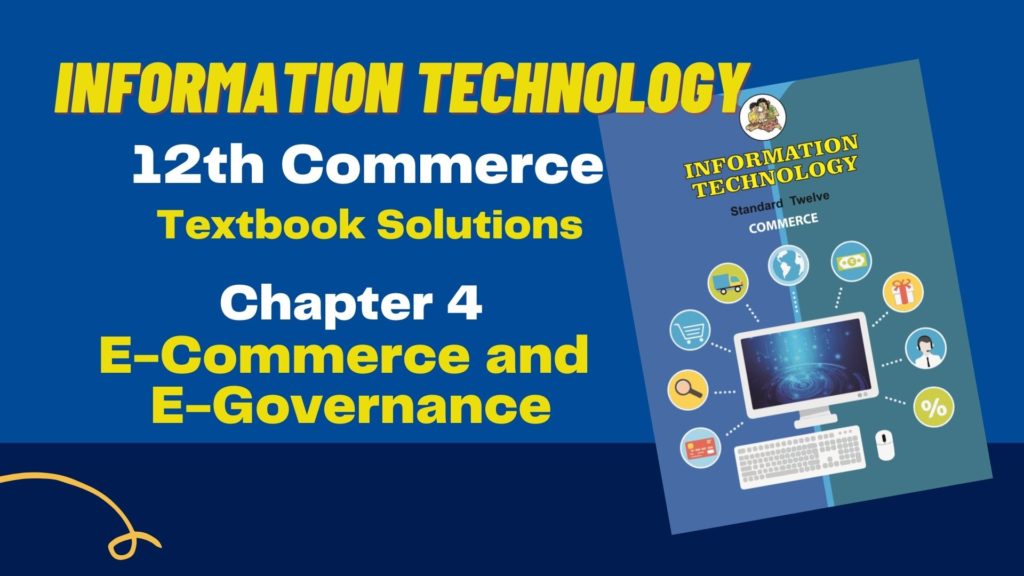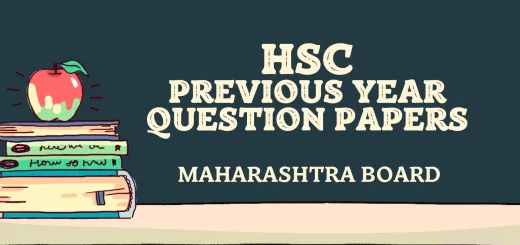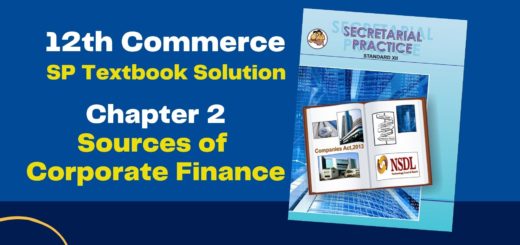12th Commerce IT Chapter 4 Exercise – E-Commerce and E-Governance | Maharashtra Board (Free Solution)
Table of Contents
12th Commerce IT Chapter 4 Exercise

Chapter 4 – E-Commerce and E-Governance
Q 1. Fill in the blanks
1) E-Commerce’s scope is Global.
2) A customer can do shopping B2C online using type of E-Commerce.
3) The Execution phase consist of Order and Delivery.
4) E-wallet is a type of Prepaid account in which a user can store his/her money for any future online transaction..
5) EDI is Electronic exchange of information..
6) The G2C type of e-governance refers to the government services which enable citizens to get access to wide variety of public services.
7) The e-governance which provides safe and secure inter-relationship between domestic or foreign government is G2G.
Q 2. State True/False.
1) C2C type of E-commerce deals with Business and Customer.
Answer: False
2) The lack of a personal touch can be a disadvantage for many types of services and products in E-commerce.
Answer: True
3) Checking the balance of holiday is an example of G2C.
Answer: False
4) E-commerce provides more options to compare and select the cheaper and better options.
Answer: True
5) M-commerce can be used through desktop computer.
Answer: False
Q 3. Multiple Choice Question.
(1 correct answer)
1) Invoice and payment are included in …………………. phase of trade cycle.
a) Presale
b) execution
c) settlement
d) After sale
2) License renewal is an example of …………… e-governance.
a) G2C
b) G2B
c) G2G
d) G2E
Solution of other subjects
Solution of Chapters of IT
1 – 2 – 3 – 4 – 5 – 6
Free online lecture on above topic – Click Here
Q 4. Multiple Choice Question.
(2 correct answer)
1) Encryption consist of two processes …………. and ………….. .
a) encryption
b) signature
c) decryption
d) digitization
e) security
2) Social commerce is a subset of electronic commerce that involves social media like ………… and …………a) Facebook
b) Instagram
c) gmail
d) whatsapp
e) software
Q 5. Match the following.
| A | B |
| 1) M-commerce | a) Coded form of data |
| 2) Cipher Text | b) B2B |
| 3) EDI | c) E-bill payment |
| 4) Wholesaler to Retailer | d) Paperless exchange of information |
| 5) License renewal services | e) G2G |
| 6) Online facility to employees like leave | f) G2C |
| 7) Government agencies share same database | g) G2E |
1) – c) E-bill payment
2) – a) Coded form of data
3) – d) Paperless exchange of information
4) – b) B2B
5) – f) G2C
6) – g) G2E
7) – e) G2G
Q 6. Answer in brief.
1) Explain phases of trade cycle.
Answer: A trade cycle is the series of exchanges, between a customer and supplier that take place when a commercial exchange is executed. A general trade cycle consists of following phases:
a) Pre-Sales
It consists of two steps like Search and Negotiate. Customer search for required website for products to be purchased. In Negotiate step customer find a supplier who offers good quality product at cheaper price and then customer agrees the terms forwarded by supplier.
b) Execution
This phase consists of Order and Delivery. The customer sends an order for the selected product and after processing the order, customer receives delivery of the product.
c) Settlement
This phase consists of an Invoice (if any) and Payment. Invoice means customer will receive a bill for purchased product and after confirmation of received product, customer will pay for the same.
d) After-Sales
This phase consists of warranty and After Sale Services. In warranty period, customers will get all maintenance services for free or at minimum cost.
2) Explain M-Commerce.
Answer:
a) M-Commerce is the buying and selling of goods and services through wireless handheld devices such as
smartphones and tablets.
b) As a form of e-commerce, m-commerce enables users to access online shopping platforms without needing to use a desktop computer.
c) Some of applications of M-Commerce are mobile banking, ticket booking, E-bill payment, online auctions, and stock market trading.
3) Describe process of encryption.
Answer:
Encryption
a) Encryption is widely used on the internet to protect user information being sent between a browser and a server.
b) This includes passwords, payment information, and other personal information that should be considered private.
c) The process consists of two processes as encryption and decryption.
d) Encryption converts Plain text ( readable form of data ) into Cipher Text (coded form of data) means non-readable form of data.
e) Decryption is exactly opposite process of encryption. It converts Cipher text into Plain text.
Encryption is of two types-
Symmetric (Private-Key Encryption )
Asymmetric (Public-Key Encryption)
4) What is E-governance?
Answer:
E-Governance
a) E-Governance signifies the implementation of information technology in the government processes and functions so as to cause simple, moral, accountable and transparent governance.
b) The basic purpose of e-governance is to simplify processes for all, i.e. government, citizens, businesses etc. at National, State and local levels.
c) E-governance delivers SMART government. (S- Simple, M-Moral, A-Accessible, R-Responsive, T-Transparent Government)
Solution of other subjects
Solution of Chapters of IT
1 – 2 – 3 – 4 – 5 – 6
5) List out advantages of E-commerce.
Answer:
Advantages of E-Commerce
a) Global scope
E-commerce provides the sellers with a global reach. Now sellers and buyers can meet in the virtual world, without barrier of place (geography).
b) Electronic transaction
E-commerce reduces the paper work and significantly lower the transaction cost. E-Commerce enables the use of credit cards, debit cards, smart cards, electronic fund transfer via bank’s website and other modes of electronic payment.
c) Cost Saving
E-commerce application provides users with more options to compare and select the cheaper and better option. It helps in reducing the cost of searching a product. E-commerce has enabled rural areas to access services and products, which are otherwise not available to them.
d) Anytime shopping
One other great advantage is the convenience. A customer can shop 24×7. The website is functional at all times, it does not have working hours like a shop.
e) No intermediaries
Electronic commerce also allows the customer and the business to be in touch directly, without any intermediaries. This allows for quick communication and transactions.
f) Public services
E-commerce helps the government to deliver public services such as healthcare, education, social services at a reduced cost and in an improved manner.
6) Which are the different types of e-governance?
Answer:
Types of E-Governance
E-Governance is of 4 types depending on the specific types of services.
a) Government-to-Citizen (G2C)
Government-to-citizen refers to the government services which enable citizens to get access to wide variety of public services. Most of the government services fall under G2C. It helps the ordinary people to reduce the time and cost to conduct a transaction. A citizen can have access to the services anytime from
anywhere. Furthermore, Many services like license renewals and paying tax are essential in G2C. It also focuses on geographic land barriers.
b) Government-to-Business (G2B)
Government to business is the exchange of services between Government and Business organizations. G2B provides access to relevant forms needed to comply. The G2B also consists of many services exchanged between business sectors and government. It aims at eliminating paper work, saving time, cost and establish transparency in the business environment, while interacting with government.
c) Government-to-Government (G2G)
Government-to-Government refers to the interaction between different government departments, organizations and agencies. In G2G, government agencies can share the same database using online communication. The government departments can work together. In conclusion, G2G services can be at the local level or the international level. Likewise, it provides safe and secure inter-relationship between domestic or foreign governments.
d) Government-to-Employee (G2E)
The Government-to-Employee is the internal part of G2G sector. Furthermore, G2E aims to bring employees together and improvise knowledge sharing. Similarly, G2E provides online facilities to the employees like applying for leave, reviewing salary payment record and checking the balance of holiday. The G2E sector provides human resource training and development. So, G2E is also the relationship between employees, government institutions and their management.
7) State two examples of G2E services.
Answer:
Government-to-Employee (G2E)
a) The Government-to-Employee is the internal part of G2G sector. Furthermore, G2E aims to bring employees together and improvise knowledge sharing.
b) G2E provides online facilities to the employees like applying for leave, reviewing salary payment record and checking the balance of holiday.
c) The G2E sector provides human resource training and development. So, G2E is also the relationship between employees, government institutions and their management.
d) Some effective examples of successful implementation of E-Governance projects are e-Mitra project (Rajasthan), e-Seva project (Andhra Pradesh), CET (Common Entrance Test)
8) Write any four advantages of e-governance.
Answer:
Advantages of E-governance
a) Reduced corruption
b) High transparency
c) Increased convenience
d) Direct participation of constituents
e) Reduction in overall cost.
f) Expanded reach of government
Extra Questions
Choose a single correct answer from the given options.
1. E-Commerce stands for ______.
a) Engage Commerce
b) Evolve Commerce
c) Electronic Commerce
d) Easy Commerce
2. _____ is the process of byuing and selling of goods and services using electronic medium.
a) E-Commerce
b) Digital Certificate
c) E-Governance
d) Digital Signature
3. _____ Commerce focuses on the exchange of products and services through personal interactions.
a) E-Governance
b) Electronic
c) Digital Signature
d) Traditional
4. _____ Commerce has limited to business hours.
a) Traditional
b) Electronic
c) Digital
d) E-Governance
5. _____ Commerce provide face to face intraction.
a) Electronic
b) Traditional
c) Digital
d) Web hosting
6. In _____ Commerce scope is local.
a) Electronic
b) Divisional
c) Digital
d) Traditional
7. _____ Commerce has no time limits, it is available 24 x 7.
a) Electronic
b) Divisional
c) Traditional
d) Digital
8. In _____ Commerce trading activities are online via the internet.
a) Digital
b) Traditional
c) Electronic
d) Divisional
9. In _____ Commerce scope is a global.
a) Digital
b) Electronic
c) Traditional
d) Divisional
10. _____ Commerce reduces the paper work and lower the transaction cost.
a) Electronic
b) Divisional
c) Traditional
d) Local
11. _____ application provides users with more options to compare and select the cheaper and better option.
a) Z-Commerce
b) G-Commerce
c) E-Commerce
d) V-Commerce
12. _____ Commerce allows the customers and the business to be in touch directly without any intermediaries.
a) Traditional
b) Electronic
c) Divisional
d) Digital
13. In _____ model business sells its product directly to a customer.
a) C2B
b) B2C
c) B2B
d) C2C
14. In ______ model, business sells its products to an intermediate buyer who then sells the product to the final customer.
a) C2B
b) B2C
c) B2B
d) C2C
15. In _____ model, consumer helps consumer to sell their assets by publishing their information on the website.
a) C2B
b) B2C
c) B2B
d) C2C
16. On-line auction is example of _____ model.
a) C2B
b) B2C
c) B2B
d) C2C
17. In _____ model, consumers have products or services of value that can be cosumed by businesses.
a) C2B
b) B2C
c) B2B
d) C2C
18. A _____ is the series of exchanges between a customer and supplier that takes place when a comercial exchange is executed.
a) EDI
b) trade Cycle
c) Encryption
d) Decryption
19. _____ phase of Trade Cycle consists of two steps like search and negotiate.
a) Presale
b) Execution
c) Settlement
d) After sales
20. _____ phase of Trade Cycle consists of order and Delivery.
a) Presale
b) Execution
c) Settlement
d) After sales
Detailed explanation videos of the above chapter – Click Here
12th Commerce IT Textbook Solutions
| Chapter Name | Solution Link |
| 1) Advanced Web Designing | Click Here |
| 2) Digital Marketing | Click Here |
| 3) Computerised Accounting with GST | Click Here |
| 4) E-Commerce and E-Governance | Click Here |
| 5) Database Concepts using Libre Office Base | Click Here |
| 6) Enterprise Resource Planning (ERP) | Click Here |
Check out other posts related to the 12th Commerce
| Textbook Solutions of 12th Commerce (All Subjects) | Click Here |
| Free pdf of 12th Commerce Textbooks | Click Here |
| 12th Commerce IT MCQ Preparation (Online Test) | Click Here |
| 12th Commerce Paper Pattern and Chapter Wise Marks Distribution | Click Here |
| Sample Paper of 12th Commerce for Practice | Click Here |
| Solved Sample papers of 12th Commerce to improve Paper Presentation | Click Here |
| Old Question Papers of 12th Commerce with solution (All Subjects) | Click Here |


